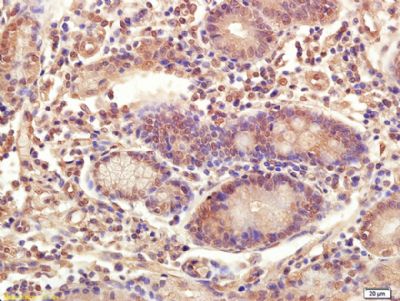Twist2 Polyclonal Antibody
Purified Rabbit Polyclonal Antibody (Pab)
- 产品详情
- 实验流程
Application
| IHC-P, IHC-F, IF, E |
|---|---|
| Primary Accession | Q8WVJ9 |
| Reactivity | Rat, Pig, Bovine |
| Host | Rabbit |
| Clonality | Polyclonal |
| Calculated MW | 18124 Da |
| Physical State | Liquid |
| Immunogen | KLH conjugated synthetic peptide derived from human Twist2 |
| Epitope Specificity | 75-160/160 |
| Isotype | IgG |
| Purity | affinity purified by Protein A |
| Buffer | 0.01M TBS (pH7.4) with 1% BSA, 0.02% Proclin300 and 50% Glycerol. |
| SUBCELLULAR LOCATION | Nucleus. Cytoplasm. Note=Mainly nuclear during embryonic development. Cytoplasmic in adult tissues. |
| SIMILARITY | Contains 1 basic helix-loop-helix (bHLH) domain. |
| SUBUNIT | Efficient DNA binding requires dimerization with another bHLH protein. Forms a heterodimer with TCF3/E12. Also interacts with MEF2C (By similarity). |
| DISEASE | Focal facial dermal dysplasia 3, Setleis type (FFDD3) [MIM:227260]: A form of focal facial dermal dysplasia, a group of developmental defects characterized by bitemporal or preauricular skin lesions resembling aplasia cutis congenita. FFDD3 is characterized by distinctive bitemporal scar-like depressions resembling forceps marks, and additional facial features, including a coarse and leonine appearance, absent eyelashes on both lids or multiple rows on the upper lids, absent Meibomian glands, slanted eyebrows, chin clefting, and hypo- or hyperpigmentation of the skin. Histologically, the bitemporal lesion is an ectodermal dysplasia with near absence of subcutaneous fat, suggesting insufficient migration of neural crest cells into the frontonasal process and the first branchial arch. Note=The disease is caused by mutations affecting the gene represented in this entry. |
| Important Note | This product as supplied is intended for research use only, not for use in human, therapeutic or diagnostic applications. |
| Background Descriptions | Twist2 (Twist homolog 2) is a basic helix-loop-helix (bHLH) transcription factor which acts as a transcriptional repressor. It binds to the E-box consensus sequence 5'-CANNTG-3' and inhibits transcriptional activation by MYOD1, MYOG, MEF2A and MEF2C. Efficient DNA binding requires dimerization with another bHLH protein. Twist2 inhibits the premature or ectopic differentiation of preosteoblast cells during osteogenesis. |
| Gene ID | 117581 |
|---|---|
| Other Names | Twist-related protein 2, Class A basic helix-loop-helix protein 39, bHLHa39, Dermis-expressed protein 1, Dermo-1, TWIST2, BHLHA39, DERMO1 |
| Target/Specificity | In the embryo, highly expressed in chondrogenic cells. In embryonic skin, expressed in the undifferentiated mesenchymal layer beneath the epidermis which later develops into the dermis. Expressed in early myeloid cells but not in lymphoid cells in the liver. Expression also detected in the secretory ependymal epithelium of the choroid plexus primordium. In the adult, expressed in secreting glandular tissues and tubules. |
| Dilution | IHC-P=1:100-500,IHC-F=1:100-500,IF=1:100-500,ELISA=1:5000-10000 |
| Format | 0.01M TBS(pH7.4) with 1% BSA, 0.09% (W/V) sodium azide and 50% Glyce |
| Storage | Store at -20 °C for one year. Avoid repeated freeze/thaw cycles. When reconstituted in sterile pH 7.4 0.01M PBS or diluent of antibody the antibody is stable for at least two weeks at 2-4 °C. |
| Name | TWIST2 |
|---|---|
| Synonyms | BHLHA39, DERMO1 |
| Function | Binds to the E-box consensus sequence 5'-CANNTG-3' as a heterodimer and inhibits transcriptional activation by MYOD1, MYOG, MEF2A and MEF2C. Also represses expression of pro-inflammatory cytokines such as TNFA and IL1B. Involved in postnatal glycogen storage and energy metabolism (By similarity). Inhibits the premature or ectopic differentiation of preosteoblast cells during osteogenesis, possibly by changing the internal signal transduction response of osteoblasts to external growth factors. |
| Cellular Location | Nucleus {ECO:0000255|PROSITE-ProRule:PRU00981, ECO:0000269|PubMed:11062344}. Cytoplasm Note=Mainly nuclear during embryonic development. Cytoplasmic in adult tissues |
| Tissue Location | In the embryo, highly expressed in chondrogenic cells. In embryonic skin, expressed in the undifferentiated mesenchymal layer beneath the epidermis which later develops into the dermis Expressed in early myeloid cells but not in lymphoid cells in the liver. Expression also detected in the secretory ependymal epithelium of the choroid plexus primordium. In the adult, expressed in secreting glandular tissues and tubules. |
Research Areas
For Research Use Only. Not For Use In Diagnostic Procedures.
Application Protocols
Provided below are standard protocols that you may find useful for product applications.
终于等到您。ABCEPTA(百远生物)抗体产品。
点击下方“我要评价 ”按钮提交您的反馈信息,您的反馈和评价是我们最宝贵的财富之一,
我们将在1-3个工作日内处理您的反馈信息。
如有疑问,联系:0512-88856768 tech-china@abcepta.com.
¥ 1,500.00
Cat# AP58127























 癌症的基本特征包括细胞增殖、血管生成、迁移、凋亡逃避机制和细胞永生等。找到癌症发生过程中这些通路的关键标记物和对应的抗体用于检测至关重要。
癌症的基本特征包括细胞增殖、血管生成、迁移、凋亡逃避机制和细胞永生等。找到癌症发生过程中这些通路的关键标记物和对应的抗体用于检测至关重要。 为您推荐一个泛素化位点预测神器——泛素化分析工具,可以为您的蛋白的泛素化位点作出预测和评分。
为您推荐一个泛素化位点预测神器——泛素化分析工具,可以为您的蛋白的泛素化位点作出预测和评分。 细胞自噬受体图形绘图工具为你的蛋白的细胞受体结合位点作出预测和评分,识别结合到自噬通路中的蛋白是非常重要的,便于让我们理解自噬在正常生理、病理过程中的作用,如发育、细胞分化、神经退化性疾病、压力条件下、感染和癌症。
细胞自噬受体图形绘图工具为你的蛋白的细胞受体结合位点作出预测和评分,识别结合到自噬通路中的蛋白是非常重要的,便于让我们理解自噬在正常生理、病理过程中的作用,如发育、细胞分化、神经退化性疾病、压力条件下、感染和癌症。






